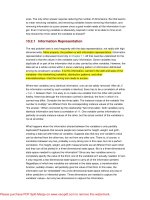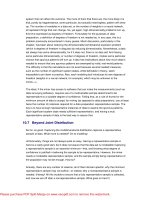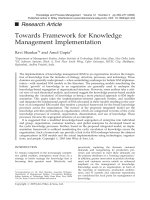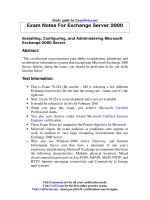Tài liệu . . . And Communications For All A Policy Agenda for a New Administration ppt
Bạn đang xem bản rút gọn của tài liệu. Xem và tải ngay bản đầy đủ của tài liệu tại đây (1.75 MB, 375 trang )
. . . AND
COMMUNICATIONS FOR ALL. . . AND
COMMUNICATIONS FOR ALL
A Policy Agenda for a New Administration
Edited by
Amit M. Schejter
LEXINGTON BOOKS
A DIVISION OF
ROWMAN & LITTLEFIELD PUBLISHERS, INC.
Lanham • Boulder • New York • Toronto • Plymouth, UK
LEXINGTON BOOKS
A division of Rowman & Littlefield Publishers, Inc.
A wholly owned subsidiary of The Rowman & Littlefield Publishing Group, Inc.
4501 Forbes Boulevard, Suite 200
Lanham, MD 20706
Estover Road
Plymouth PL6 7PY
United Kingdom
Copyright © 2009 by Lexington Books
A
ll rights reserved. No part of this publication may be reproduced, stored in a
retrieval system, or transmitted in any form or by any means, electronic, mechanical,
photocopying, recording, or otherwise, without the prior permission of the publisher.
This volume is the product of the Future of American Communications (FACT) Working
Group assembled at the Institute for Information Policy (IIP) at the Pennsylvania State
University in December 2007, with a supporting grant provided by the Media Democracy
Fund (MDF). The editing was done by Judy Maltz, and the project coordinator was
Jonathan Obar.
British Library Cataloguing in Publication Information Available
Library of Congress Cataloging-in-Publication Data
—And communications for all : a policy agenda for a new administration / edited by
Amit M. Schejter.
p. cm.
Includes index.
ISBN-13: 978-0-7391-2919-7 (cloth : alk. paper)
ISBN-10: 0-7391-2919-8 (cloth : alk. paper)
ISBN-13: 978-0-7391-2920-3 (pbk. : alk. paper)
ISBN-10: 0-7391-2920-1 (pbk. : alk. paper)
ISBN-13: 978-0-7391-3483-2 (electronic)
ISBN-10: 0-7391-3483-3 (electronic)
1. Telecommunication policy—United States. I. Schejter, Amit.
HE7781.A75 2009
384.0973—dc22 2008044657
Printed in the United States of America
@
™
The paper used in this publication meets the minimum requirements of American
National Standard for Information Sciences—Permanence of Paper for Printed Library
Materials, ANSI/NISO Z39.48–1992.
Preface: A Second Chance vii
Introduction: Summary of Recommendations xi
Part I: Frameworks
1 Broadband, Internet, and Universal Service: Challenges to the
Social Contract of the Twenty-First Century 3
Jorge Reina Schement
2 Digital Media, Modern Democracy, and Our Truncated
National Debate 29
Ernest J. Wilson III
3 Public Scholarship and the Communications Policy Agenda 41
Robert W. McChesney
4 International Benchmarks: The Crisis in U.S. Communications
Policy thr
ough a Comparative Lens 57
Amit M. Schejter
Part II: Infrastructures and Industries
5 Competition and Investment in Wireline Broadband 81
Marvin Ammori
6 U.S. Cable TV Policy: Managing the Transition to Broadband 109
Richard D. Taylor
7 A Spectrum Policy Agenda 137
Jon M. Peha
— v —
Contents
8 The Way Forward for Wireless 153
Rob Frieden
9 Rethinking the Media Ownership Policy Agenda 167
Philip M. Napoli
Part III: Access
10 Universal Service 181
Krishna Jayakar
11 America’s Forgotten Challenge: Rural Access 203
Sharon L. Strover
12 Municipal Broadband 223
Andrea H. Tapia
13 The Future of the E-Rate: U.S. Universal Service Fund Support
for Public Access and Social Services 239
Heather E. Hudson
Part IV: Content
14 Public Service Media 2.0 263
Ellen P. Goodman
15 Creating a Media Policy Agenda for the Digital Generation 281
Kathryn Montgomery
16 Race and Media: Several Key Proposals for the Next
Administr
ation 301
Leonard M. Baynes
Index 325
About the Contributors 343
— vii —
I
t is rare that policymakers get a second chance, but today, they may be
fortunate enough to have such an opportunity. As this book goes to press in
the fall of 2008, it is aimed to assist the new administration that will be elected
this fall to seize the opportunity, learn from past mistakes, and design a com-
munications policy that will be forward-looking, make information technolo-
gies available to all, enhance their contribution to a more vibrant democratic
sphere, to a greater sense of social responsibility, and to an improved quality
of life for all Americans.
Twelve years after the landmark Telecommunications Act of 1996 was
passed, the media and telecommunications industries in the United States
are more concentrated and less competitive than they were beforehand.
Fewer Americans are taking advantage of new technologies in comparison
to their peers in other industrialized countries; the technologies avail-
able to them are inferior, yet at the same time they are required to pay
more for them. The combination of shortsighted, though well-intended,
policies and the tendency to cater to the powerful interests of incumbent
industries—telephone, cable, and broadcasting companies—has led to
disastrous results.
Half a century ago, the United States was light years ahead of the rest of the
world when it came to providing its citizens with access to communication
networks and when it came to the sophistication of these networks. Today,
it lags behind most of the developed and some developing nations on both
counts. Even worse, evidence suggests that in the absence of dramatic policy
changes, this trend will only intensify.
Preface
A Second Chance
The policy agenda set down in these pages was prepared by a group of
sixteen scholars of eleven major American universities. Media and commu-
nications studies scholars, economists, legal scholars, public policy scholars,
education researchers, engineers, and social scientists from various disci-
plines, they joined together to form the Future of American Communications
Working Group under the auspices of the Institute for Information Policy at
Penn State University. Their work was supported by a generous grant from
the Media Democracy Fund. Each member of the working group enjoyed a
free hand in drawing up his or her recommendations, and no vote or unani-
mous agreement regarding each recommendation was taken. In this sort of
interdisciplinary work, it is our belief that the whole is greater than the sum
of its parts.
The policy prescriptions we offer take into account the current crisis plagu-
ing U.S. communications policy, as policymakers strive to support a future in
which the United States will reclaim its position as a world leader in the field.
Indeed, policy alone will not suffice, but it is an indispensable tool in this ef-
fort. While each chapter represents solely the views of its author, some com-
mon threads are evident throughout, among them the following:
v
The United States should adopt a comprehensive and pro-active national
information policy that promotes social inclusion as well as ubiquitous,
high-quality, open Internet service.
v
The policy should be technologically neutral, embracing all communica-
tions technologies and redefining the breadth and scope of longstanding
corrective policies.
v
The policy should address the four Cs of access: connectivity, capabil-
ity, content, and context. The goal of connectivity, at the heart of most
policies that aspire to increase access and/or bridge the digital divide,
represents but a first step toward functional access and empowerment.
Capability, content, and context must be woven into any strategy seeking
to achieve a better informational future for all.
v
A balance needs to be struck between measures that are market-led and
measures that are government-led.
v
National policy should recognize that a vibrant national broadband net-
work is comprised of both public goods and consumer products and that
it is designed to promote the former and create truly competitive markets
for the emergence of the latter.
Our recommendations are based on a consensus that all communications
services, including interactive, information, and entertainment services, will
eventually be provided over broadband. At the same time, we believe that the
viii Preface
Internet reduces uncertainty for users in important contexts, encourages civic
engagement, enables the creation of social capital, and is shaped through user-
generated content.
Our national goal, therefore, should be making broadband ubiquitous. All
policies and rules adopted in the next several years should be viewed as tran-
sitional, their objective being the smooth transition to a national, content-
rich, nondiscriminatory broadband network. But even if the Internet is kept
open and broadband becomes inexpensive and ubiquitous—two huge policy
challenges—that alone will not resolve all the key issues. Derailing hypercom-
mercialism, creating vibrant noncommercial zones, and protecting privacy are
other important goals to be addressed in these pages.
The forward-looking policy we propose stems from a vision of how the
industry should look in the future, and mid-range policy measures are recom-
mended to take us there.
The recommendations of the working group members are outlined in the
following chapter, the introduction and summary. More detailed descriptions
are provided in the individual chapters. Following the summary, the book is
divided into four sections. In section I, Frameworks, Jorge Reina Schement
of Rutgers University discusses the new contract for universal access in the
twenty-first century; Ernest J. Wilson III of the University of Southern Cali-
fornia Annenberg School for Communications urges us to revisit the tradi-
tional perspectives for viewing the media industries; Robert W. McChesney of
the University of Illinois argues that scholars of all disciplines need to engage
in the policy debate, and Amit M. Schejter of Penn State provides a compari-
son of communications policies across the globe that sheds light on where the
United States has erred.
The recommendations outlined in the introduction are discussed in fur-
ther detail in section II—I
nfrastructures and Industries. Marvin Ammori of
the University of Nebraska College of Law discusses the wire
line industry for
delivering high-speed Internet access and the means by which to make it more
competitive; Richard D. Taylor of Penn State prescribes the way the cab
le in-
dustry should be prepared for the transition to an all-broadband network; Jon
M. Peha of Carnegie Mellon offers a middle ground in sp
ectrum management
that balances between property claims and the call for a spectrum commons,
and proposes the launching of a national emergency communications system;
Rob Frieden of Penn State discusses the w
ireless industry and prescribes ways
by which to increase competition among wireless operators for the benefit of
consumers; and Philip M. Napoli of Fordham proposes a new framework to
guide the debate on o
wnership in the media industries. In section III—Access—
Krishna Jayakar of Penn State lays the foundation for a new approach to uni-
ver
sal service; Sharon L. Strover of the University of Texas proposes a strategy
Preface ix
to confront the unique challenges facing rural communities; Andrea H. Tapia
of Penn State outlines the focus for municipalities planning on providing
broadband services; and Heather E. Hudson of the University of San Francisco
identifies the key components for efficient and innovative distribution of the
E-rate. In section IV—Content—Ellen P. Goodman of the Rutgers School of
Law Camden discusses the future of p
ublic broadcasting as it becomes public
service media in the digital age; Kathryn Montgomery of American University
presents the challenges for p
rotecting young audiences in the digital future, in
particular the overlooked teenage demographic; and Leonard M. Baynes of
St. John’s University School of Law addresses the challenges of increasing mi-
nor
ity representation in both traditional and new media in light of the sharp
decline in minority ownership in the past decade.
The book targets many different audiences—scholars, students, policymak-
ers, and activists. It is also quite a unique project in that it is the collective
work of sixteen independent scholars motivated solely by a commitment to
serve the public interest. Unlike much scholarship in telecommunications
debates, none of the scholars accepted or solicited corporate funding for
this project. The book is also comprehensive, addressing as wide a variety of
pertinent issues as possible. Each recommendation presented here stands on
its own logic and represents the views of its author alone. It should be noted,
however, that at various stages of the process, various proposals outlined here
were scrutinized and challenged by members of the working group.
The working group meetings and the writing of the different chapters took
place during the first nine months of 2008 and went to press in the fall just as
we learned that Barack Obama will lead the new administration. We believe
that the challenges we identify and the route we each offer provide an essential
roadmap for his new administration as it confronts the twenty-first-century
challenge of ensuring a ubiquitous, reliable, nondiscriminatory, and innova-
tive communications network for all.
University Park, PA, November 2008
x Preface
— xi —
Part I: General Recommendations
1. Congress should adopt a forward-looking national policy to facilitate
the transition of the “wireline,” “wireless,” and “cable television” indus-
tries to become part of a ubiquitous national open broadband network,
regulated primarily at the federal and state levels.
2. T
he new policy should ensure that:
a) Consumers can access all content and all applications of their choice
online, without interference from any network provider; and
b) Attach any device to any network, wired or wireless.
3. Congress and the Federal Communications Commission (FCC) should
gather domestic and international information on broadband facts and
policies to develop best practices.
4.
In the mid-range, regarding all existing industries, and in order to avoid
the creation of distorted market conditions, regulators should:
a) Encourage new entrants by any means, anywhere; and
b) Pay special regulatory attention to the rise of metered broadband
services.
Introduction
Summary of Recommendations
Part II: Infrastructures and Industries
The Existing “Wireline” Industry
With regard to the existing wireline industry, Congress and the FCC (each
within its capacity as stated) will need to:
1.
Adopt unbundling and wholesale access policies focused on broadband
access, not on voice or other particular communications; Congress should
define the unbundled elements narrowly and set the price formula in
primary legislation rather than delegating more broadly to the FCC.
2.
Modify forbearance procedures to protect pro-competitive policies from
“deregulatory” commissions.
3. Enact structural or functional separation to better align carrier incen-
tives and enforce pro-competitive policies.
4.
Set up an operational “arbitrator” to ensure incumbents do not under-
mine competition through operational delay.
5. Ens
ure entrants have access to local rights of way.
6. Require divestiture of unused copper and cable lines, when fiber is
deployed.
7. Provide financial assistance if necessary for deployment of open,
unbundled fiber networks.
8. Enact network neutrality.
9. Include the public in any political debates or compromises that affect the
future of our nation’s broadband networks.
The Existing “Cable” Industry
All policies and rules adopted over the next several years with regard to the
existing cable industry should be viewed as transitional, intended to facilitate
the smooth conversion to a national, interconnected, nondiscriminatory
broadband network, creating the virtual equivalent of line sharing with re-
spect to the delivery of video services. That said, a number of current issues
need to be addressed:
1. T
he a la carte issue should be separated from content regulation.
2. Multicast must carry should not be adopted.
3. Rules prohibiting arbitrary or anti-competitive discrimination in net
-
work management need to be enacted promptly. Serious discussion of
the nuances of this issue should continue. Full disclosure of network
management practices would be a useful first step.
xii Introduction
4. The introduction of metered or capped broadband services should be
closely monitored as they could lead to unanticipated harmful conse-
quences. Usage-based pricing is potentially anti-competitive, arbitrary,
slows growth, fails to recognize the current reality of the evolving video
market, and creates perverse incentives.
5. T
he FCC should begin proceedings to:
a) Require all televisions built following the earliest practicable date to
accept direct Internet connections;
b) Establish “open Internet TV” standards, just as it did with advanced
television standards (these could be multiple standards), including
standards for remote controls and integrated media browsers; and
c) Set a “date certain” for the transition to an all IP network in which
all screens connect to the Internet through an open standard that
supports remote controls and media browsers.
For the longer term:
1.
The challenges for protecting video over “open” broadband networks
from undue dominance or predatory behavior are entirely different than
with cable television. The bottlenecks may not be the local carriers but
could be proprietary software, appliances, search engines, DRM, and ad-
vertising. The FCC should embark on studying these potential threats.
2.
States
should be encouraged to pass laws franchising wired video/broad-
band delivery systems, and replacing municipal cable franchises (to the
extent permitted under federal law). A model law would be helpful in
this regard, to encourage common standards.
3.
State video franchises should be nonexclusive in fact as well as in form,
and issued and supervised under an appropriate state agency
4. PEG access will need assistance to make the transition from analog to IP:
a) states should determine and collect franchise fees or sales taxes on
video programming (consistent with federal law) and return to
communities an appropriate amount for access groups;
b)
state video franchises should include a mandatory definition of the
technical quality of digital PEG access of at least equal to commer-
cial video programs (channels) previously delivered as analog; and
c) municipalities should be able to claim any residual authority not
expressly preempted by federal or state law or regulation.
The Spectrum
While many might believe that the shortage of available spectrum, the “life-
blood” of wireless systems, is an inevitable result of the laws of physics, it is
Introduction xiii
more rooted in the now-outdated laws and traditions of the federal govern-
ment. Numerous measurement studies have shown that at any given time and
location, much of the prized spectrum sits idle.
1.
With regard to the management of spectrum, policies should be imple-
mented that:
a) alleviate today’s shortage of available spectrum;
b) decrease the cost of today’s wireless services; and
c) create opportunities for new wireless products and services.
2. These goals can be achieved through new spectrum policies that:
a) encourage spectrum users to reduce their spectrum needs;
b) allow and encourage more spectrum sharing; and
c) decrease the cost of initial access to spectrum.
3. Near-term opportunities for achieving these long-term goals include
reaping more spectrum dividends from the DTV transition in addition
to the reallocation of many television channels in a 2008 auction:
a) It
should be possible to deploy wireless systems in the television
“white spaces,” and the debate over how best to use that spectrum
should be expanded.
b) This is an extraordinary opportunity to construct a nationwide
broadband network that serves local first responders, eventually
replacing the inefficient and ineffective systems of today, and that
is financially sustainable. If it does, it will save spectrum, taxpayer
dollars, and lives.
4
. The next president should demand a detailed inventory of federal spec-
trum and an account of how this essential resource is used. Except for
those bands that must be protected for reasons of national security, the
results of this inventory should be made public. This would allow existing
companies, entrepreneurs, and researchers to seek out opportunities to
use the spectrum more efficiently. Those who find opportunities could
make their case to the NTIA, the current license-holder, and Congress.
5.
In
addition to making more spectrum available, policy reform could
make the spectrum that comes available via auction accessible to more
potential license-holders. Under current policy, the auction winner
makes a one-time payment to the U.S. Treasury equal to the winning
bid. Instead, the auction winner should make an annual payment equal
to the winning bid for as long as it retains the license. This would greatly
reduce the funds that an auction winner needs initially, thereby allowing
small entrepreneurial firms to compete with the giants. This arrange-
ment would also encourage license-holders to surrender spectrum if
their plans should fail, leaving the spectrum underutilized.
xiv Introduction
The Wireless Industry
Cutting-edge wireless services, such as true broadband access to the Internet,
are not widely available in the United States, nor do national carriers regularly
display global best practices in the nature, type, and pricing of services they
offer. Wireless carriers appear able to delay investment in next generation net-
works, because the carriers have concentrated on leveraging money to acquire
market share and buy out competitors.
1. T
he FCC must:
a) begin to address the dangers of further concentration of the industry;
b) recognize the need to subject wireless carriers to different degrees
of regulatory oversight since the many types of services they offer
trigger different degrees of regulatory oversight;
c)
retain streamlined common carrier regulation for conventional wire-
less telecommunications services and calibrate any further deregula-
tion to an increase in sustainable, facilities-based competition;
d)
intervene with regard to information and video services only when
necessary to ensure that wireless carriers operate accessible net-
works. This would not necessitate common carrier regulation, but
it would require wireless carriers to establish clear service terms and
conditions and to report instances where competitive necessity sup-
ports diversification in price and quality of service;
e)
adopt a wireless “Carterfone” policy, which would provide subscrib-
ers with the option of attaching an unsubsidized handset free of any
carrier imposed attachment restrictions;
f
) prohibit carriers from favoring content supplied by corporate affili-
ates or ventures that seek to buy preferential treatment;
g)
not continue refraining from telecommunications service regula-
tion of CMRS carriers until additional sustainable, facilities-based
competition arises. In the absence of new players in the market, the
FCC should not approve transactions that would lead to further
market consolidation; and
h
) promote wireless technology alternatives to wireline networks when
allocating funds that target universal service goals. Together with
state public utility commissions, it should use reverse auctions to
achieve lowest-cost bidding for service to high-cost areas subject to
quality of service benchmarks. Before using reverse auctions the FCC
should allow wireless carriers to qualify as eligible telecommunica-
tions carriers based on the wireless carrier’s actual costs instead of the
current practice of applying the incumbent wireline carrier’s costs.
Introduction xv
2. Congress should explicitly state that state public utility commissions
and state courts can adjudicate disputes that pertain to quality of service
and interpretation of service agreements. In the absence of legislation,
the FCC should enforce existing truth in billing regulations and require
CMRS operators to provide understandable service agreements that
clearly specify all charges, fees, taxes, and surcharges. It should also void
compulsory arbitration clauses.
3.
The executive branch, Congress, and the FCC need to remain on guard
against trends that would prevent wireless carriers from providing a
competitive alternative to legacy technologies.
Media Ownership
Policymakers’ goals should be focused on maximizing our contemporary
potential for a democratic media system, on maximizing the contemporary
technological tools at hand to craft a media system that is as diverse and com-
petitive as it can be and that serves the informational needs and interests of
local communities to the fullest extent that is technologically and economi-
cally possible. As a result:
1.
In assessing and formulating media ownership policies, our current
media system needs to be compared with its contemporary potential—
not with its past.
2.
Subjective value judgments about what level of ownership restrictions
needs to be applied in order to best reflect fundamental First Amend-
ment, and democratic principles cannot (and should not) be removed
from the equation.
3.
The primary goal of media ownership policies is not to preserve or
promote the health of established industry sectors, particularly when it
comes at the expense of the development of new industry sectors.
4. In assessing the contemporary media environment, the number of
outlets or channels is far too superficial a unit of analysis. Instead, the
distribution of resources for the production of content should be the
focus. It is essential that policymakers and policy analysts see the forest
through the trees and avoid confusing channel or outlet availability with
content availability.
5.
Recent iterations of the FCC’s media ownership proceedings seem to have
started from the position that, if harms associated with relaxing or elimi-
nating particular ownership regulations could not be effectively demon-
strated, then the regulations would be relaxed or eliminated. It would
seem more than reasonable for policymakers to engage in an analytical
xvi Introduction
process that assesses not only the potential harms associated with relax-
ing media ownership regulations, but also the potential benefits.
6. In
assessing and formulating media ownership policies, demands for
rigorous data analysis must be accompanied and supported by rigorous
data gathering.
7. In assessing and formulating media ownership policies, “putting the
horse back in the barn” is not impossible. In fact, history tells us that,
if the political will is there, such reversals in policy direction are indeed
possible.
Part III: Access
Universal Service Policy
A future universal service policy can help prepare the United States for the
competitive challenges that lay ahead, most prominently, the need to catch
up with the rest of the developed world and assume a dominant role in the
emerging broadband economy.
1. Sho
rt term universal service challenges include:
a) The question of universal service funding: If the new administration
does not address the question of universal service funding, it will
not be able to find solutions for any of the other questions confront-
ing the universal service programs. Policymakers’ ability to expand
the contribution base is limited; therefore, it is imperative in the
short term that expenditures are capped at sustainable and effective
levels for the various USF-supported programs. Specifically for the
high-cost areas program, we recommend that a single service pro-
vider be identified in each territory to offer service using the most
cost-efficient technology—this service provider may be identified
through auctions or other appropriate mechanisms.
b) T
he lack of accountability and monitoring in universal service pro-
grams. This challenge calls for their improvement as well as for the
introduction of stronger institutional mechanisms to investigate
allegations of fraud or misappropriation of funds.
c)
The inability of a growing percentage of households to have access
to basic telephone service: federal incentives to states to actively pro-
mote Lifeline and Link-Up programs. Better enforcement of existing
consumer protection laws or a new law specific to telecommunica-
tions is needed to protect consumers against aggressive marketing
Introduction xvii
of telecommunication services—a leading cause of disconnection
because it causes unpredictable increases in monthly bills.
d) T
he proposals of the Federal-State Joint Board on Universal Service
for reorganizing the high-cost areas program to create three new
platform-specific funds—a broadband fund, a mobility fund, and a
provider of last resort (POLR) fund should be replaced by encour-
aging the deployment of cost-efficient multiple services platforms
such as WiMax, through funding support as well as other means,
such as spectrum allocations and standard-setting. If implementa-
tion is devolved to the states, there has to be active federal standard-
setting and monitoring.
For the long run, universal service policies need to move beyond the tradi-
tional focus on access.
2.
Emphasis should shift from promoting network take-up through afford-
ability (“low rates”) to promoting it through increasing the value that
consumers derive from network services.
3.
Instead of providing a common service to all consumers uniformly
(plain old telephone service—POTS), the new universal service pro-
grams should offer a multiplicity of services, with consumers able to
choose the services that they value the most.
4.
Policymakers should recognize that subscriptions in the new telecom-
munications environment will be driven by the quality and heterogene-
ity of services and by the ability of consumers to choose the services
most valuable to them. As a result they need to pay attention to the
middle of the value production chain, i.e., the place where new service
innovations occur.
5.
Unlike POTS, new telecommunications services require a degree of
knowledge and skill on the part of consumers. Universal service policies
in the new environment must incorporate efforts to promote digital
literacy and training.
6.
In taking the cue from universal service policies evolving around the
globe, the “new universal service” should build on four dimensions:
a) supporting network deployment;
b) aiding network take-up by promoting digital literacy and consumer
training;
c) providing incentives for service/business innovation; and
d) creating support infrastructures that enable the deployment of new
services.
Of these, support for network deployment is the only one emphasized by
traditional universal service policies.
xviii Introduction
Rural Access
A special challenge lies with regard to access in rural regions, in which roughly
17 percent of the U.S. population lives. Broadband subscription rates in rural
regions are twenty-one percentage points lower than in urban and eighteen
percentage points lower than in suburban regions, even though there is an
equivalent level of interest in subscribing to broadband in both regions.
An alternative vision of universal service and its contribution to rural
populations must focus on cultivating the ability of people to improve their
lives—with the specific nature of those improvements to be determined
by the people themselves. This, in turn, requires renewed focus on self-
determination in the communications/telecommunications environment—a
process made more viable with the onset of new media, networks, and new
types of telecommunications services. Public policy that acknowledges not
just parity with urban regions, but also self-determination, could make tele-
communications more meaningful to life in rural regions.
The challenges that lie ahead in this field are several:
1.
Recognizing the significance of this infrastructural element to all aspects
of life in rural and nonrural regions of the country, and incorporating
into economic, educational, and social policies the budgets and practices
that will help exploit the potential of telecommunications.
2.
Conceding that marketplace dynamics do not deliver timely services
to more remote and less populous regions and developing improved
mechanisms to improve services in those regions.
3. Crafting programs that systematically augment the range of services
and available training and expertise around broadband services in rural
regions.
4. The four factors that affect rural Internet subscription and use are:
a) infrastructure availability;
b) content applicability;
c) pricing; and
d) training.
Viable programs that influence these factors can take several forms. Since
simple deployment alone, however, appears to be an insufficient driver, any
programs that stimulate deployment must be linked to investments in train-
ing and use. The recommendations regarding rural connectivity are:
1.
Adopt a national broadband policy that is capable of guaranteeing sus-
tained investment in telecommunications infrastructure. The United
States requires constantly updated capabilities that are affordable and
available to all.
Introduction xix
2. Establish grants for Internet training. These could be block grants
and must be outcomes-oriented and outcomes-dependent. The target
populations could be not only individual users but also small businesses.
Increasing small business use of the Internet could have tremendous
economic impact on rural regions. Grants within states themselves
could go to various entities, including nonprofits, towns, counties, and
local government units.
3.
Universal service funds should be used to enhance projects undertaken
by communities that are designed to extend their telecommunications
capabilities. These funds could be used to match local investment in in-
frastructure, connectivity, public access, and similar access technologies.
They could also be used to provide broadband infrastructure develop-
ment and incentives to communities that can demonstrate their readi-
ness to develop their own facilities/expertise as well as their abilities to
use these facilities. Communities should match federal investment in
some manner. They could purchase broadband services or develop their
own infrastructures.
4.
Invest in community college–based Internet applications capabilities
classes for individuals and small businesses and create incentives for
colleges that enroll small business owners, with some outcome-based
measure being the trigger for an incentive “subsidy” or payment.
5.
Create “rural leadership academies” that select aspiring or actual rural
leaders for two to three weeks of leadership training that would include
training not only in using the Internet but also in running computer
education clinics or courses, in the “nuts and bolts” of broadband in-
frastructure, and in resource-sharing across institutions. These leaders
would serve the purpose of catalyzing Internet availability and use in
their respective communities, which would be left to decide what invest-
ments and services make most sense for them.
Municipal Broadband
Local governments have a role to encourage municipalities:
1.
To own and manage wireless networks or at least to take an active role
in creating them.
2. To design, build, and deploy wireless service that is as reliable as the
other common utilities, such as water, power, and telephone, with clear
performance standards established.
3. To
design, build, and deploy wireless service coverage, which should in-
clude every household, business, organization, public space, and public
transit corridor included in a municipality.
xx Introduction
4. To charge for the wireless service prices that are affordable and nondis-
criminatory, in order to ensure universal access for all.
In order to achieve the goals of this policy, it is essential to:
1. Id
entify a common standard for wireless broadband deployment, in-
cluding Wi-Fi meshing.
2. Reallocate underutilized spectrum for unlicensed citizen access.
3. Expand the universal service fund (USF) to cover broadband service, in
-
cluding USF eligibility, distribution, and availability of funds for various
types of broadband providers.
4.
Encourage the federal government to offer grants to fund broadband
deployment.
The E-Rate
The USF programs for schools, libraries, and rural health care should become a
permanent component of universal service. The FCC should maintain respon-
sibility for the USF programs for schools, libraries, and rural health care, but
special advisory committees should be established, comprised of representatives
from NTIA, DOE, and HHS, as well as from professional educational, library,
and health care organizations. These advisory committees should also include
experts on the utilization of ICTs and on the evaluation of ICT programs.
1. T
he following E-Rate policies should be continued:
a) funding should be limited to connectivity and related facilities;
b) discounts based on income and geographic region should be main
-
tained; and
c) a competitive bidding process for vendors should continue.
2. A triennial review of FCC and USAC administrative, application, and
oversight procedures should be required to improve the efficiency, ef-
fectiveness, and transparency of the disbursement of funds.
3.
Sources that support the factors critical to effective utilization of ICTs
need to be identified: capacity-building for teachers and others who use
ICTs, development and exchange of effective content for education, and
other development and contextual applications (based on factors such
as language, culture, ethnicity, and disabilities).
4.
A small percentage of USF funds should be used for outreach to make
more educators, librarians, and rural health care providers aware of the
programs and for evaluation to update and analyze data on program
utilization and to assess impacts of USF support.
Introduction xxi
Part IV: Content
Public Broadcasting
The need for public investment in media content and services has not abated,
since the commercial market on its own is still unable to provide the media
environment that makes for a thriving democracy. The task of redesigning
federal public media subsidies provides an opportunity not only to take ac-
count of new technologies and modes of media production but also to rethink
the purpose of noncommercial media in our society. For too long, the policy
debates over public broadcasting have centered on “fairness and balance” in
the programming that stations air and on whether or not the federal govern-
ment should continue to subsidize entities in the existing structure. That
debate today needs to turn to structural reform.
The objective of public broadcasting has always been to provide media content
that the market will not. Broadly speaking, it is content that promotes citizen-
ship, personal growth, and social cohesion. These goals remain important, but
they need to be reinterpreted in the new media environment. Specifically, media
policy needs to focus more on public media, not just public broadcasting.
What is needed is a system that focuses on supporting a wide range of non-
commercial programs and services and that promotes universal access to, and
opportunity to e
ngage with, quality media content. This transition, though
clearly needed, is politically difficult. It involves at least three components:
1. Rest
ructuring the current system so that funds are diverted from the
operation of broadcast facilities.
2. Redefining the entities that are entitled to public media funding.
3. Revamping the system of copyright exemptions and licenses so that
public media entities have access to content on reasonable terms, can
distribute public media content across all platforms, and can make con-
tent available for citizen engagement and reuse.
Digital Media and Young Audiences
The Internet and other new digital technologies hold great promise for youth,
particularly for education, community-building, political involvement, and
civic engagement. Therefore, marketing policies should only be a small part
of a much broader media research and policy agenda. Among the issues that
must be addressed are universal access to broadband, E-Rate policies, funding
for noncommercial platforms, and support for education and training. If our
goal is to have a generation that can help the country tackle its most pressing
problems, then we need to provide it with a media environment that will help
its members become effective contributors to our society and our democracy.
xxii Introduction
The next few years provide an important opportunity to develop commer-
cial safeguards for children and teens, particularly in two key areas—public
health and personal privacy. Several steps should be taken in the short term
to enable the United States to move toward a fair and equitable media and
marketing system for children and youth.
1.
The appropriate congressional committees should hold hearings on
contemporary digital marketing practices targeted at children and ado-
lescents.
2.
The FTC, the FCC, and Congress should work together, along with the
industry and the public health and child advocacy communities, to de-
velop a new set of rules governing digital marketing to children.
3. New regulations must take into account the full spectrum of advertis-
ing and marketing practices across all media, and apply to all children,
including adolescents. Particular attention needs to be paid to how food
and beverage products are promoted.
4.
Among the areas of special focus should be the following:
a) requirements for full disclosure of data collection practices, includ
-
ing so-called nonpersonally identifiable information, targeted at
children and adolescents;
b)
restrictions on personal profiling and behavioral targeting aimed at
individuals under the age of eighteen; and
c) restrictions on certain practices that may be deceptive, such as “viral
videos” and other forms of stealth marketing that do not disclose, at
the outset, the companies behind the campaigns.
5. Clearly, government has a role to play in protecting adolescents’ privacy.
The proposals presented by the coalition of children and health groups,
all of which would be within the agency’s current statutory authority,
would be an appropriate and necessary initial step for the FTC to take.
These would include:
a)
adopting, as part of the industry’s voluntary guidelines, a definition
of “sensitive data” to include “the online activities of all persons
under the age of eighteen”; and
b) prohibiting “the collection of sensitive data for behavioral advertis-
ing purposes.”
Digital Media and Broadcasting for Minorities
At this time and in the near future, the Internet and broadband technologies
are not and will not serve as substitutes for broadcasting among minorities.
Since minorities have less access to the Internet and broadband technologies,
Introduction xxiii
broadcast television, and radio, which reach 99 percent of the population and
are consumed more frequently than Internet services by African Americans
and Latinos/as, still represent for them a valid separate market.
The FCC’s Report and Order and Third Further Notice of Rulemaking,
which adopted nondiscrimination rules for market transactions and advertis-
ing, is insufficient to combat this problem, and with the shortage of spectrum
to provide for new station licenses much of the effort to diversify media own-
ership has to focus on the sale of broadcast licenses in secondary markets. The
following measures should be adopted:
1.
Revive the FCC’s Minority Tax Certificate Program—a program repealed
in 1995 by Congress.
2. Reinstitute the distress sale policy and apply it to socially and economi-
cally disadvantaged businesses.
These programs should pass constitutional muster, both because after thirteen
years of sharp decline in minority ownership, enough data is available to jus-
tify their reimplementation, and because they are narrowly tailored to meet
the need for diversification of media ownership.
3.
The United States should join the rest of the world and affirm its respon-
sibility for protecting mutual respect within the diverse composition of
its population. A statute should make diversity of media voices a core
value and require that every action that the FCC takes is evaluated in the
context of its effect on diversity of media ownership and media voices.
4.
In order for people of color to have more access and content in the new
world of ubiquitous broadband, two types of policies need to be imple-
mented:
a) policies that ensure universal access to broadband and network
neutrality; and
b) expansion of the tax certificate, distress sale, and SBA loan programs
to providers of online content.
xxiv Introduction









